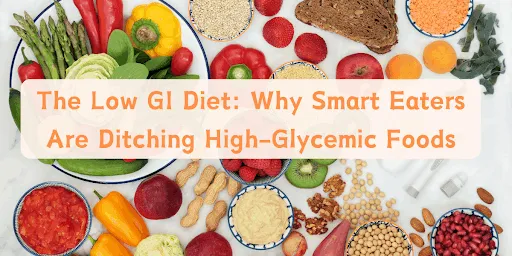Are you dealing with itching, hives, digestive issues, and unexplained headaches after eating? It can be histamine intolerance, and the culprit can be histamine, a compound found in a variety of foods. For some individuals, an excessive histamine intake can trigger several symptoms. That's where a low-histamine diet helps, which mainly focuses on low-histamine foods to relieve symptoms and improve overall health. Let's explore the blog and know what to eat and what to avoid to feel better!
What Is Histamine Intolerance?
Histamine intolerance is a rare condition that occurs due to the accumulation of histamine in the body or the inability of the body to metabolize (break down) histamines through the enzyme diamine oxidase. It is estimated to impact 1% to 3% of the population worldwide.
This leads to the following histamine intolerance symptoms:
-
Headaches or migraines
-
Hives, skin redness, swelling, and itching
-
Nasal congestion
-
Runny nose
-
Fatigue
-
Nausea or digestive problems
-
Anxiety
-
Dizziness
-
Abdominal pain
-
Diarrhea
What Is a Low-Histamine Diet?
A low-histamine diet is a restrictive dietary approach. It involves avoiding foods that are extremely high in histamine or those that stimulate histamine release and focusing on low-histamine foods, which are fresh and unprocessed. It is often used for a temporary period to recognize and eliminate them from the daily diet, as they might be causing histamine-related symptoms.
Low Histamine Diet: Foods to Eat
Here is the list of low-histamine foods that you can add to your diet:
1. Fresh Fruits
-
Fresh fruits like apples, pomegranates, and grapes are considered low-histamine options. They can be enjoyed without typically causing histamine-related symptoms, as they have low histamine levels.
-
Fruits such as cherries, pears, plums, and peaches are well-tolerated by those with histamine sensitivity.
-
Including these fruits in your diet provides a range of vitamins, minerals, and antioxidants.
2. Fresh Vegetables
-
Fresh vegetables such as arugula, artichokes, and broccoli are the best option, as they contain low histamine levels compared to aged or fermented veggies.
-
Onions, peppers, cucumbers, and spaghetti squash suit a low-histamine diet.
-
These low-histamine foods can be incorporated into salads, stir-fries, and various dishes.
3. Fresh Herbs
-
Fresh herbs like basil, parsley, and oregano add flavor to your meals without triggering histamine intolerance, as they are low in histamine compared to aged or processed herbs.
-
Rosemary, cilantro, thyme, and turmeric are other low-histamine herbs that can enhance the culinary experience.
-
A study revealed that curcumin, found in turmeric, showed an effective anti-allergic property.
4. Gluten-Free Grains
-
Quinoa and brown rice are gluten-free grains that are generally safe for individuals with histamine sensitivity, as they prevent the gluten’s histamine-triggering effects.
-
They serve as versatile staples and can be used in a variety of dishes.
-
These grains are a good source of carbohydrates and can provide energy while being low in histamines.
5. Freshly Cooked Legumes
-
Chickpeas, black beans, and kidney beans are the best legumes compared to canned ones, as the canning process raises the histamine levels.
-
They are excellent plant-based sources of protein, dietary fiber, and essential nutrients.
-
However, it's crucial to soak and cook them to eliminate some of the histamine they may contain.
6. Starchy Vegetables
-
Starchy vegetables like sweet potatoes, yams, butternut squash, and winter squash are low-histamine options.
-
They are rich in complex carbohydrates and provide essential vitamins and minerals.
-
These vegetables can serve as a satisfying and nutritious component of your meals while being gentle on histamine sensitivity.
7. Fresh Meat
-
Fresh meats such as chicken, turkey, lean ground beef, and lamb are considered low in histamine. The key is to ensure their freshness and proper storage.
-
Freshness prevents histamine build-up, so purchase and store these meats correctly.
-
Avoid aged, ground, smoked, and cured meats, as they have higher levels of histamine.
8. Fresh Fish
-
Fresh fish, particularly varieties like salmon, is a great choice for those on a low-histamine diet. It's a credible source of high-quality protein and healthy omega-3 fatty acids.
-
Again, freshness is essential, so buy and store fish properly to maintain its low histamine content.
-
Avoid aged or improperly stored fish, as with aging, the histamine levels increase.
9. Carob
-
Carob is often used as a chocolate substitute in recipes and is considered low in histamines.
-
It has a naturally sweet flavor and is used in various desserts and as a beverage flavoring.
-
Unlike chocolate, which is known to be high in histamines, carob is a safe alternative for individuals with histamine sensitivity.
10. Almond, Cashew, and Hemp Milk
-
Nut-based alternatives like almonds, cashews, and hemp milk are typically low in histamines.
-
They can be used as dairy milk substitutes in various recipes, including smoothies, cereals, and baked goods.
-
These milk options are suitable for those with histamine intolerance.
11. Hemp, Flax, and Chia Seeds
-
These seeds are generally low in histamine and provide a healthy dose of essential fatty acids, fiber, and various nutrients.
-
They can be added to smoothies, yogurt, oatmeal, or used in baking to enhance the nutritional value of your meals.
12. Coconut Oil
-
Coconut oil is considered low in histamines and does not trigger the release of the natural histamines of the body.
-
It can be safely used for cooking, sautéing, and dressing dishes without causing histamine-related symptoms.
-
This oil is a source of healthy monounsaturated fats, while coconut oil is known for its unique flavor and potential health benefits.
This is a low-histamine food plan that you can consider in your daily routine. However, if you experience any discomfort while on this diet, consult a doctor for proper advice.
Foods To Avoid That Are High In Histamine
People with histamine intolerance should avoid or limit foods that are high in histamine or can trigger histamine release. Some common foods to avoid with histamine intolerance include:
Foods high in histamine:
-
Alcoholic beverages, especially beer and red wine
-
Eggplant
-
Canned or smoked fish
-
Fermented foods, like kefir and sauerkraut
-
Aged cheeses
-
Processed meats such as salami, pepperoni, and bacon
-
Shellfish
-
Long-stored nuts, such as peanuts, almonds, cashew nuts, and pistachio nuts
-
Chocolates and other cocoa-derived products
-
Seitan
-
Rice vinegar and other vinegar-containing foods
-
Ready meals
-
Salty snacks and sweets with artificial colorings and preservatives
Foods that trigger the release of histamine:
-
Most citrus fruits, such as lemons, oranges, and limes
-
Cocoa and chocolate
-
Walnuts and peanuts
-
Papaya, strawberries, pineapples, raspberries, plums, guava, kiwi, pears, and bananas
-
Legumes, such as chickpeas, green beans, lentils, soybeans, and peanuts
-
Tomatoes
-
Wheat germ
-
Most vinegars, like balsamic vinegar, cider vinegar, and wine vinegar
-
Additives, including benzoate, food dyes, sulphites, glutamate, and nitrites
Foods that block diamine oxidase activity (DAO):
-
Beer
-
Red wine
-
White wine
-
Black tea
-
Mate tea
-
Energy drinks
Tips for Low-Histamine Diet
To eliminate foods higher in histamine and manage a low-histamine diet, follow these tips:
-
Cook all the food properly.
-
Consume foods as fresh as possible.
-
Note down whatever you eat along with the time in a food diary every day.
-
Avoid leftover foods, especially meat-containing products, as storage raises histamine levels.
-
Record the date and time of any symptoms for comparison.
-
Avoid junk food or extremely processed foods.
-
Be kind to yourself, as this diet is not easy to follow.
-
Read labels of food products to check for histamine-containing ingredients such as vinegar, malt, preservatives, and food colorings.
-
Do not consider this diet for more than four weeks.
-
Speak with a certified nutritionist or dietitian about ingesting all the essential nutrients while considering this diet.
Pros and Cons of a Low-Histamine Diet
With the pros of low low-histamine diet come some cons. Here are those pros and cons:
|
PROS |
CONS |
|---|---|
|
Can significantly relieve symptoms such as disgestive issues, skin problems, and headaches. |
Being restrictive, it eliminates variety of nutritious foods such as fermented foods, citrus fruits, and tomatoes. |
|
Helps identify foods that cause histamine-associated reactions. |
Hard to follow, as it needs careful daily meal planning, avoiding leftovers, and label reading. |
|
Reduces the accumulation of histamine, which can contribute to better energy levels, mood, and sleep. |
Leads to the risk of deficiency of vitamins or minerals due to long-term food restriction. |
|
Supports gut health by focusing on intake of food such as whole and fresh foods, which can improve digestion. |
Not a cure to histamine intolerance but can manage symptoms. |
|
Can be personalized when triggers are recognized. |
Lead to social limitations, as eating at social occassions or events can be very challenging. |
How to Know if You Have Histamine Intolerance?
Tracking the symptoms can only help you know you have histamine intolerance. You can visit the doctor for a proper diagnosis. They can help detect this condition with the following tests:
-
Skin prick test 405 (not always reliable)
-
Blood test, which helps monitor diamine oxidase activity (DOA), an enzyme responsible for the metabolism of histamine.
If you are diagnosed with histamine intolerance, which occurs due to excessive histamine levels or inadequate DOA, the doctors can suggest some supplements to maintain the correct balance. The supplements may include vitamin B-6, copper, vitamin C, and zinc, as low intake of these micronutrients can contribute to a higher risk of histamine intolerance.
Final Thoughts
A low-histamine diet can be life-saving for people struggling with histamine intolerance. Though this diet may seem restrictive and challenging, it can bring significant relief from symptoms. However, it's not a long-term treatment plan, so under a doctor's guidance, you can reintroduce those foods to detect individual triggers. If you experience any discomfort during this diet, seek medical help.
Related Read: Essential Tips for Starting a Low Histamine Diet
Frequently Asked Questions
Is broccoli high in histamine?
No, broccoli is low in histamine.
How to lower histamine level?
Consider low histamine foods (e.g., apples, pomegranates, onions, peppers, chocolate, chia seeds), manage stress, and take supplements after consulting a doctor.
Can the FODMAP diet help manage histamine intolerance?
Yes, it can help manage histamine intolerance in some people, especially those who experience severe diarrhea, as it helps lower histamine levels in the body.
What drink is a natural antihistamine?
Ginger tea, lemon juice, and green tea are the best antihistamines as they have natural antihistamine effects, which help relieve allergy symptoms.
Who needs a low histamine diet?
It is generally suggested for people with histamine intolerance. However, it can also be beneficial for those struggling with inflammatory bowel disease, hay fever, certain types of allergies, celiac disease, or mast cell activation syndrome.

Reviewed by







